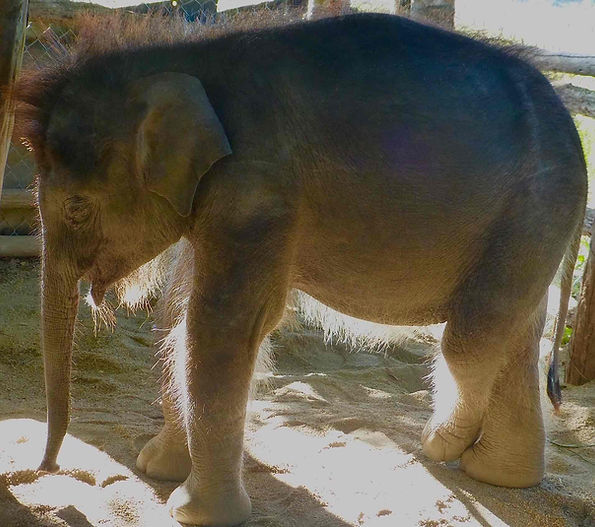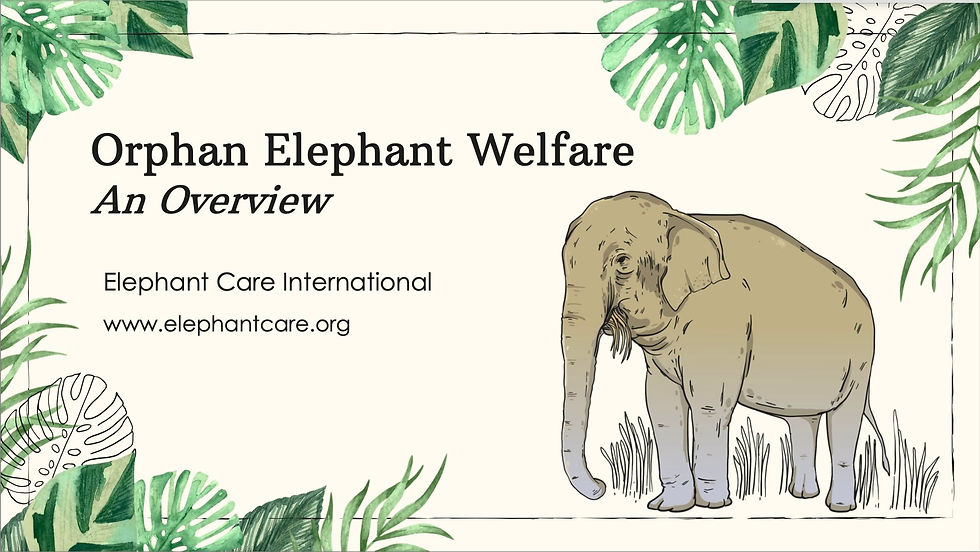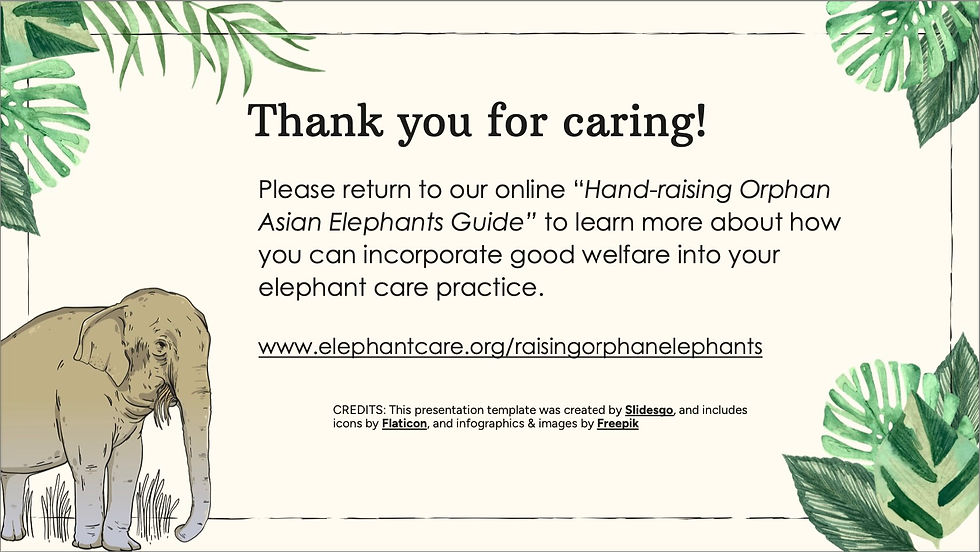
Hand-raising Orphan Asian Elephants
A Practical Guide
For Asian Elephant
Range Country Care Providers
Photo credit: Hollis Burbank-Hammarlund
Why We Developed This Guide
How Elephant Calves Become Orphans
There are many reasons why young elephants are orphaned. Human-elephant conflict is a major contributor.
Falling into ditches or wells, accidental electrocution, being caught in snares or hit by trains or vehicles, poisoned by agricultural chemicals--as well as natural disasters, such as floods--kill many wild Asian elephants, including mothers. Injured or weak elephant calves may be separated from their herd or abandoned. Unless humans step in to help, survival is unlikely.
Why This Manual is Needed
Hand-raising orphan elephants is challenging, especially if they have been injured. Even facilities with experience are not always successful. Many die within the first few months.
To date, there has been no comprehensive resource to provide practical and science-based information on how to care for orphan Asian elephant calves. Until now!
We have created a practical guide for veterinarians, veterinary technicians, mahouts, caregivers, and anyone else involved with elephant hand-rearing.
Written by an international team of Asian elephant health and welfare experts, the new Hand-Raising Orphan Asian Elephants guide includes veterinary protocols, step-by-step instructions, photos, videos, and a variety of healthcare and welfare tools to ensure young orphan elephants have the opportunity to thrive--and be returned to the wild!
From “First Encounter” to “Release Back to the Wild”—11 chapters in all. This new guide will give orphaned elephants a second chance. (Scroll down to see the list of chapters.)
Because we hope to reach a broad audience, we have tried to use clear and succinct language and have defined medical terms that may not be familiar to all.
We welcome feedback and will update this guide as new information becomes available.
Understanding the Basic Concepts of 'Good Welfare' is a Good Starting Point
To begin your journey towards a practical understanding of how to successfully hand-raise orphan Asian elephants--and achieve positive outcomes for their lifelong wellbeing--we encourage you to first review our slide show below. Click on the image below to start or click here to download a PDF version.
A collaborative project of:

Contributors & Reviewers
Dr. Susan K. Mikota - Veterinarian
Executive Director & Director of Veterinary Programs and Research, Elephant Care International (Read more)
Dr. Willem Schaftenaar - Veterinarian
Veterinary advisor to the Elephant Taxon Advisory Group (Europe) (Read more)
Dr. B. Vijitha Perera - Chief Wildlife Veterinarian, Department of Wildlife Conservation, Elephant Transit Home, Udawalawe, Sri Lanka (Read more)
Dr. Ellen Dierenfeld
Member, American Zoo and Aquarium Association’s Nutrition Advisory Group; Past President, Comparative Nutrition Society, and; Advisor to the online Handrearing Resource Center (Read more)
Dr. Bhaskar Choudhury - Veterinarian
Manager and Head Veterinarian at Wildlife Trust of India (Read more)
Dr. Khyne U. Mar - Veterinarian
Research Fellow, The University of Sheffield, Department of Animal and Plant Sciences (Read more)
Project Partner, Fundraiser, and
Website Producer
Hollis Burbank-Hammarlund
Founder/Director, Work for Wild Life International (Read more)
Funding Generously Provided By
Dr. Betsy Coville - Veterinarian
Coville-Triest Family Foundation
PHOTO CREDITS: Unless identified otherwise, all photographs featured in this Guide were taken by the above Contributors, Reviewers, and Website Producer and may only be used with permission.




Click on image above to start slideshow.
Topics in This Guide
This guide includes 11 chapters, other resources, and appendices.
Click on images below to access chapter content.
Photo credit: Hollis Burbank-Hammarlund
Have a question about baby elephants?
Need some help?
Have a case study to share?

Photo credit: Hollis Burbank-Hammarlund







.jpg)





